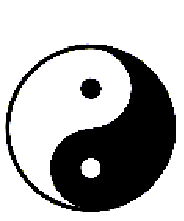|
Tai Ji
 What these Principles describe is exactly
what happens in the Tai Ji, better know as yin-yang emblem. What these Principles describe is exactly
what happens in the Tai Ji, better know as yin-yang emblem.
No Principles can be taken away from the nineteen shown, no Principle can
be added to it.
Tai Ji is the most Universal symbol.
The
Seven Principles of the Infinite Universe describe the Absolute World
(Dao) - the world of the static Heavens - as represented in the 'Former
Heaven Sequence' of the Trigram model accredited to Fu Xi.
The
Twelve Laws of Cyclic Change of the Infinite Universe describe the
Relative World (Deh) - or all visible and invisible manifestations in the
atmospheric and dynamic world - as represented in the 'Later Heaven
Sequence' according to king Wen.
The
former being depicted in a diagram called He Tu, the latter in the Luo Shu
diagram.
These principles are to be seen as one and are all of them shown in the
Tai Ji symbol, better known as yin-yang emblem.
Together, these nineteen principles of Nature form a unity with the Five
Transformations.
Yin-yang and the Five Transformations combined show the complete mechanism
of the Universe, with no exception, in macrocosmic sense, as well as in
their microcosmic appearance.
Once
you familiarized yourself with these nineteen principles and the Five
Transformations, virtually no question will remain unanswered and no
subject left 'secret', because they are the 'key' to a comprehensive
cosmological understanding.
They
are the 'Alpha' and 'Omega' of the biological, cosmological, practical,
psychological, esoteric, astronomical, physiological and alchemic
understanding of existence.
Their dietary and health implications are numerous and its exploration a
great adventure.
Through continued studies of yin-yang and the Five Transformations and
their effectuation in applied macrobiotics, Nine Star Ki, Feng Shui,
exercise and meditation, we can learn to understand and change our
physical, mental and spiritual conditions, constitutions even.
These nineteen principles have
been greatly covered in titles of Michio Kushi and George Ohsawa and are
highly recommended and an excellent starting
point for practical studies
of yin and yang and Five Transformations.
THE END
Back |
Table of content
|